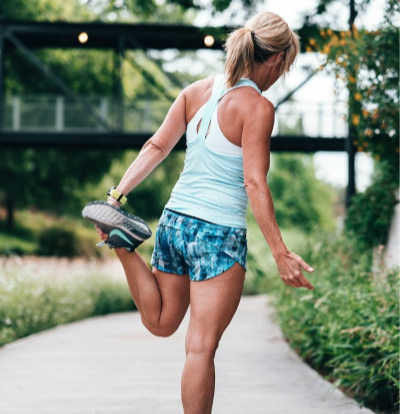How To Stretch Your Quads Correctly
To be able to answer this question, we must first look at the anatomy of the quadriceps muscles. The quads (quadriceps femoris) are made up of four muscles (hence quads!), rectus femoris, vastus intermedius, vastus lateralis, and vastus medialis. They all join at the bottom of the thigh and form the patella tendon. This tendon crosses the kneecap (patella), and inserts on the tibia – main bone of the lower leg.
If you have ever experienced knee issues you may have heard of the vastus medialis muscle, sometimes known as the VMO (vastus medialis obliquis). This muscle is notorious for being the weakest quad muscle that directly affects the patella. It attaches on the medial side (inside) of the patella, and if it is not strong enough, the risk of the patella being pulled laterally (outwards) increases. If this occurs, then knee pain arises.
The infamous ITB (ilio tibial band) works with the vastus lateralis to help pull the patella outwards (laterally)every time you activate your quads. These two muscles are considerably strong in comparison to the vastus medialis. Most active people need to do specific work to ensure they have equal length tension relationship with the muscles affecting both sides of their patella, so when they use their quads, the patella moves in the femoral groove comfortably, and does not get pulled out of alignment.
Put these factors together and it should become obvious that stretching the quads should be done in a manner to ensure the medialis is not overstretched compared to the lateralis, and that there is correct alignment with the upper and lower leg, including the knee joint. There are plenty of specific exercises that can be performed to ensure there is equal tension between the
muscles that affect the patella both laterally and medially; but that is for another article. This article is specifically about stretching the muscles of the front of the thigh correctly to help prevent muscle imbalances around the knee.
There is a lot of science behind stretching. There is also a number of different ways to stretch, these include static, dynamic, ballistic, range of motion, proprioceptive neuromuscular facilitation (PNF), active,passive and isometric, all serve different purposes for what you want to achieve as well as your current condition.
Watch this video on How To Stretch Your Quads Correctly
By Kerrie Hains
Fitness Inside Out – Mobile Personal Trainer
Brisbane, QLD

